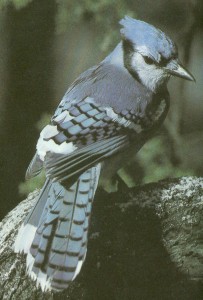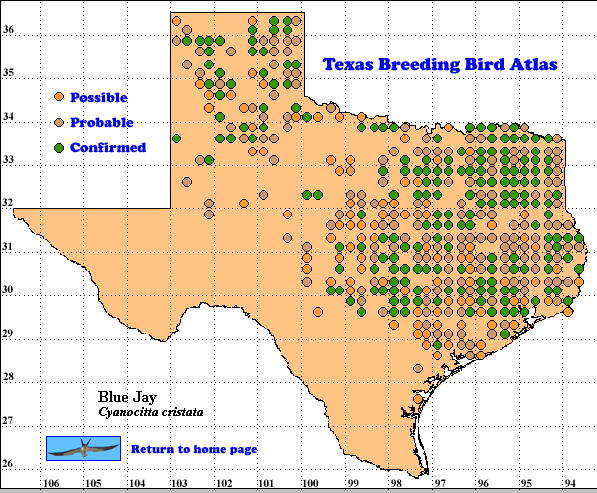While a familiar bird to most inhabitants of eastern North America, the raucous and conspicuous Blue Jay invites more study. We know mated pairs remain together all year, defending a nest site (not a territory) and raising young. In company with other Blue Jays, they may engage in group displays and mob potential predators or intruders. Like many corvids Blue Jays are omnivorous and opportunistic feeders, consuming everything from nuts to the eggs and young of smaller birds.
Some individuals (<20% of any population) may “migrate,” but our knowledge of this behavior is extremely limited. Many aspects of group behavior involving neighboring pairs are also limited. (Tarvin and Woolfenden 1999).
DISTRIBUTION. During the 1987-1992 TBBA project field work, atlasers found Blue Jay breeding in the Pineywoods, Post Oak Savannah and Blackland Prairies, northern Coastal Prairies, and eastern Edwards Plateau regions (see map in Lockwood and Freeman 2004). A number of Blue Jay breeding records were obtained in the Panhandle with a few in other regions. The Trans Pecos was the only region with no breeding records.
North American Breeding Bird Survey (BBS) data from 40 km (25 mi) routes on which Blue Jay was detected provide relative abundance values for these regions. In the Pineywoods 10-30 jays were detected per rout per year. Moving west across the Post Oak Savannah and Blackland Prairies, detections dropped to 3-10. In the eastern Panhandle detections were as high as 3-10, but dropped rapidly to <1 per route in the western Panhandle (Sauer et al. 2005). The area of detections is very similar to the overall area of breeding records on the TBBA nap.
Outside Texas, Blue Jay resides from Alberta east across Canada to Newfoundland, and across the United States from the Front Range of the Rocky Mountains to the Atlantic and Gulf Coasts (Tarvin and Woolfenden 1999, Sauer et el. 2005).
SEASONAL OCCURRENCE. Blue Jays are resident within the area defined on the TBBA map, although winter flocks may gather in areas where abundant mast (tree seeds) is available, even areas where TBBA observers did not find breeding evidence. The species breeds from early February to late July, as suggested by egg dates ranging from February 27 to July 15 (Oberholser 1974, Lockwood and Freeman 2004).
BREEDING HABITAT. Blue Jays in Texas breed from near sea level to at least 1000 m (3200 ft) in pines, oaks mixed coniferous- deciduous woodlands, as well as farms suburbs, parks and towns (Oberholser 1974, Harrison 1979). In Colorado where thus jay breeds in habitats similar to those in the Panhandle and where nesting habitat use was included in their Breeding Bird Atlas, almost half of nests were in lowland riparian deciduous habitat (1500 m [5000 ft] or below) with nearly all the rest in rural or urban situations (Kuenning 1998).
The bulky nest is placed in a crotch or on an outer branch of a tree, 1.5-15 m (5-50 ft), usually 3-7.5 m (10-25 ft) above ground. Both sexes build the nest of thorny twigs, bark, moss and leaves and lined with rootlets. The outside diameter is 18-20 cm (7-8 in), height 10-11.5 cm (4-4.5 in), inside diameter 9-10 cm (3.5-4 in) and cup depth 6.5 cm (2.5 in).
The female usually lays 4-5 (range3-6) smooth, slightly glossy, greenish buff eggs (see Harrison [1979] for photo of markings). Both sexes share incubation for 17-18 days. Brood parasitism is rare. Pairs may raise 2 broods per season. (Harrison 1979, Tarvin and Woolfenden 1999).
STATUS. Lockwood and Freeman 2004) rate Blue Jays as common residents in Texas. BBS data from 96 routes in this state provide a 95% confidence interval (There is a 95% chance that the actual population trend will be between these two numbers.) of -0.6 to +2.1% population change per year for the period 1966-2004. Across the United States and Canada, 2507 routes provided a statistically significant trend of -1.1% change per year (Sauer et al. 2005). The Texas confidence interval suggests the population of this adaptable bird may be expanding.
Text by Robert C. Tweit (2006)
Literature cited.
Kuenning, R. R. 1998. Blue Jay (Cyanocitta cristata). In Colorado breeding bird atlas, pp. 316-317 (H. E. Kingery, ed.). Colorado Bird Atlas Partnership, Denver.
Harrison, H. H. 1979. A field guide to western birds’ nests. Houghton Mifflin, Boston, MA.
Lockwood, M. W. and B. Freeman. 2004. The TOS handbook of Texas birds. Texas A&M University Press, College Station.
Oberholser, H. C. 1974. The bird life of Texas. University of Texas Press, Austin.
Sauer, J. R., J. E. Hines, and J. Fallon. 2005. The North American Breeding Bird Survey, results and analysis 1966-2004. Version 2005.1. USGS Patuxent Wildlife Research Center, Laurel MD (Web site, http://www.mbr-pwrc.usgs.gov/bbs).
Tarvin, K. A. and G. E. Woolfenden. 1999. Blue Jay (Cyanocitta cristata). In The birds of North America, No. 469 (A. Poole and F. Gill, eds.). The Birds of North America, Inc., Philadelphia, PA.

